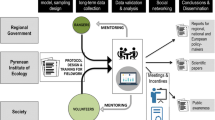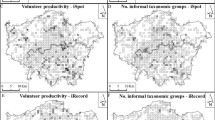Abstract
Species’ distributions, assemblage patterns and the processes influencing these are poorly understood, and urgently require study. Use of volunteers to collect data is becoming increasingly common in biodiversity research. We assess the effectiveness of volunteers sampling terrestrial savanna invertebrates in comparison to experienced researchers, and examine the potential contribution of volunteers to terrestrial invertebrate surveys. There were relatively few differences in the diversity sampled by 54 Earthwatch Institute volunteers when compared to expert researchers. The major difference was in the results from the less spatially constrained method, where experience (microhabitat selection) most affected results, and experienced researchers performed better both quantitatively (more species sampled) and qualitatively (more unique and rare species). For the more constrained and less subjective methods, our training enabled the volunteers to quickly equal the experienced experts. Volunteers’ experience in invertebrate research influenced both the researchers’ perceptions of volunteers’ capacity and the actual performance of the volunteers. This suggests that appropriate training for the methods used can help to improve volunteers’ success with the sampling. We demonstrated that volunteers collect valid data; for the most part they sample invertebrates as effectively as a trained researcher, and that using volunteers has enormous direct benefits in terms of volume of work accomplished. For invertebrate studies using volunteers, we recommend that the subjectivity of the method be minimised, that experience is compensated for by increasing volunteer effort (two volunteers = one researcher), and that there is close management of volunteers in the field to ensure ongoing data quality. Volunteers provide a valuable resource to researchers carrying out biodiversity surveys, but using volunteers to carry out a scientifically sound project is not an easy option, and should only be implemented when volunteers would make a meaningful contribution and enable an otherwise impossible project.




Similar content being viewed by others
References
Brooks T, da Fonseca G, Rodrigues A (2004) Species, data, and conservation planning. Conserv Biol 18:1682–1688. doi:10.1111/j.1523-1739.2004.00457.x
Burgess N, Mwasumbi L, Hawthorne W, Dickinson A, Doggett R (1992) Preliminary assessment of the distribution, status and biological importance of coastal forests in Tanzania. Biol Conserv 62:205–218. doi:10.1016/0006-3207(92)91048-W
Clarke K, Gorley R (2001) PRIMER v5: user manual/tutorial. PRIMER-E, Plymouth
Clarke K, Warwick R (2001) Change in marine communities: an approach to statistical analysis and interpretation. PRIMER-E, Plymouth
Cousins JA (2007) The role of UK-based conservation tourism operators. Tour Manage 28:1020–1030. doi:10.1016/j.tourman.2006.08.011
Darwall W, Dulvy N (1996) An evaluation of the suitability of non-specialist volunteer researchers for coral reef fish surveys. Mafia Island, Tanzania—a case study. Biol Conserv 78:223–231. doi:10.1016/0006-3207(95)00147-6
Fore L, Paulsen K, O’Laughlin K (2001) Assessing the performance of volunteers in monitoring streams. Freshw Biol 46:109–123. doi:10.1046/j.1365-2427.2001.00640.x
Foster-Smith J, Evans S (2003) The value of marine ecological data collected by volunteers. Biol Conserv 113:199–213. doi:10.1016/S0006-3207(02)00373-7
Gaston K (1994) Rarity. Chapman and Hall, London
Gilmour J, Saunders D (1995) Earthwatch: an international network in support of research on nature conservation. In: Saunders D, Craig J, Mattiske E (eds) Nature conservation. Beatty, Surrey, pp 627–633
Goffredo S, Piccinetti C, Zaccanti F (2004) Volunteers in marine conservation monitoring: a study of the distribution of seahorses carried out in collaboration with recreational scuba divers. Conserv Biol 18:1492–1503. doi:10.1111/j.1523-1739.2004.00015.x
Karr J (1990) Avian survival rates and the extinction process on Barro Colorado Island, Panama. Conserv Biol 4:387–391. doi:10.1111/j.1523-1739.1990.tb00313.x
Kellert S (1993) Values and perceptions of invertebrates. Conserv Biol 7:845–855. doi:10.1046/j.1523-1739.1993.740845.x
McGehee NG (2002) Alternative tourism and social movements. Ann Tourism Res 29:124–143. doi:10.1016/S0160-7383(01)00027-5
Mumby P, Harborne A, Raines P, Ridley J (1995) A critical-assessment of data derived from coral cay conservation volunteers. Bull Mar Sci 56:737–751
Myers N, Mittermeier RA, Mittermeier CG, da Fonseca GAB, Kent J (2000) Biodiversity hotspots for conservation priorities. Nature 403:853–858. doi:10.1038/35002501
Newman C, Buesching C, Macdonald D (2003) Validating mammalian monitoring methods and assessing the performance of volunteers in wildlife conservation—“Sed quis custodiet ipsos custodies?”. Biol Conserv 113:189–197. doi:10.1016/S0006-3207(02)00374-9
Pimentel D, Wilson C, McCullum C, Huang R, Dwen P, Flack J et al (1997) Economic and environmental benefits of biodiversity. Bioscience 47:747–757. doi:10.2307/1313097
Ponder W, Lunney D (eds) (1999) The other 99%. The conservation and biodiversity of invertebrates. Transactions of the Royal Society of New South Wales, Mosman, p 462
Puky M (2006) A new, volunteer-based, cost effective method for zoological mapping: the photo identification of freshwater crayfish (Crustacea: Decapoda) species and the importance of volunteers in crayfish research. Bull Fr Peche Piscicult 380–81:927–936. doi:10.1051/kmae:2006032
Slotow R, Hamer M (2000) Biodiversity research in South Africa: comments on current trends and methods. S Afr J Sci 96:222–224
Ward D, Larivière M (2004) Terrestrial invertebrate surveys and rapid biodiversity assessment in New Zealand: lessons from Australia. N Z J Ecol 28:151–159
Acknowledgments
Many thanks to all Earthwatch volunteers, field assistants and students for their time and effort in the field and in the laboratory. Funding was provided by the Earthwatch Institute and the National Research Foundation via a grant to MH. Conservation Corporation and particularly K. Pretorius, is thanked for accommodation and logistical support in Phinda. KwaZulu-Natal Wildlife and the Greater St. Lucia Wetland Park Authority are thanked for permission to work in Mkhuze and False Bay. We also thank KZN Wildlife staff for logistical support, and the Inland Invertebrate Initiative (UKZN) and Natal Museum for additional support.
Author information
Authors and Affiliations
Corresponding author
Rights and permissions
About this article
Cite this article
Lovell, S., Hamer, M., Slotow, R. et al. An assessment of the use of volunteers for terrestrial invertebrate biodiversity surveys. Biodivers Conserv 18, 3295–3307 (2009). https://doi.org/10.1007/s10531-009-9642-2
Received:
Accepted:
Published:
Issue Date:
DOI: https://doi.org/10.1007/s10531-009-9642-2




